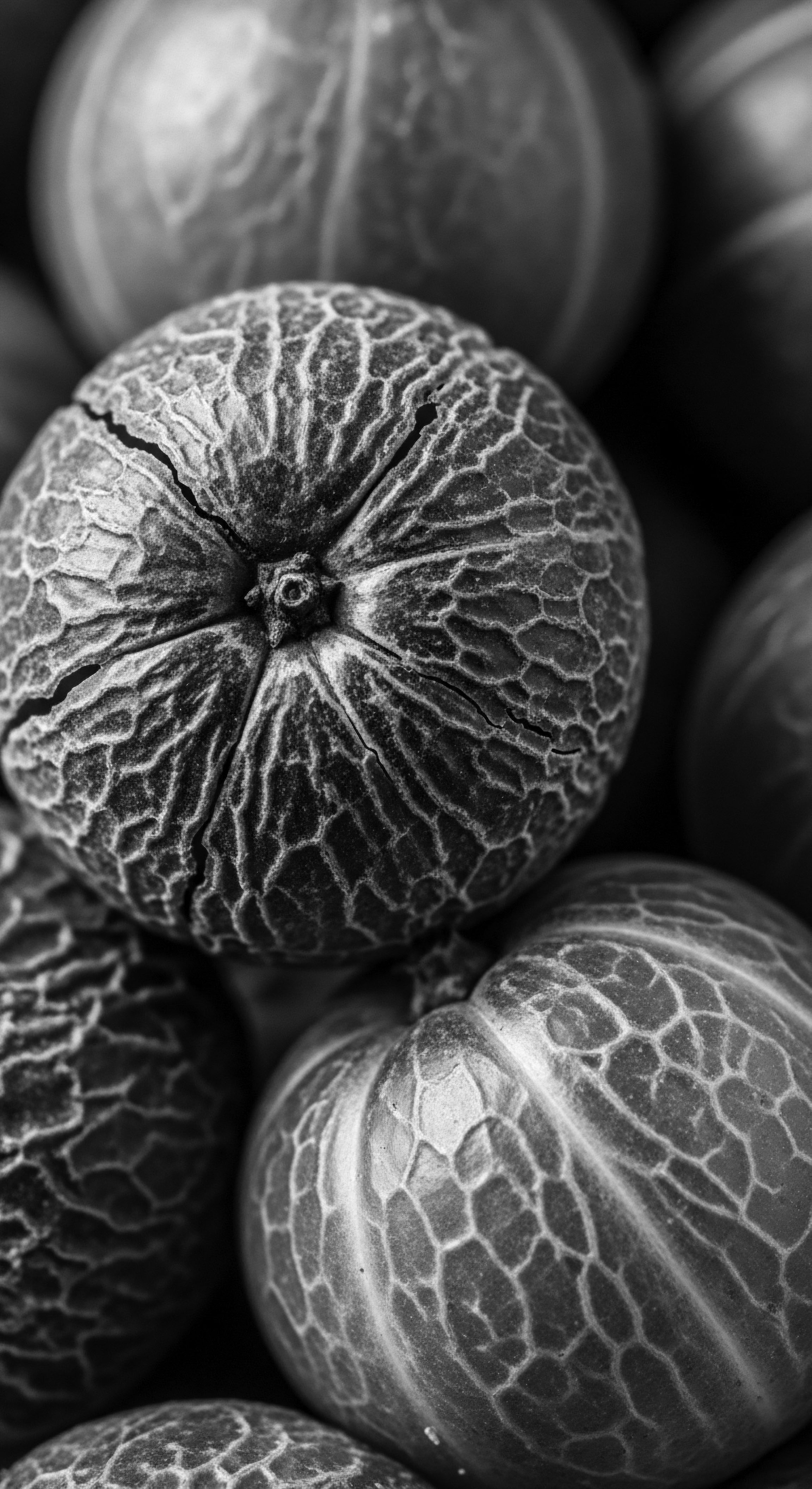
Fundamentals
The living library of Roothea holds within its digital archives a reverence for the natural world, a deep appreciation for the wisdom passed down through generations, and a particular focus on the unique journey of textured hair. Within this sacred collection, the Sapindus Mukorossi stands as a cherished entry, its very name whispering tales of ancient cleansing and tender care. This tree, commonly known as the Soapnut or Reetha, offers its fruit as a gift from the earth, a natural surfactant that has served humanity for millennia.
At its simplest, the Sapindus Mukorossi fruit, particularly its dried pericarp, produces a gentle lather when introduced to water. This foam arises from the presence of natural compounds known as Saponins. These saponins possess a unique molecular structure, allowing them to reduce the surface tension of water, thereby lifting away impurities and excess oils without stripping the hair or skin of its inherent moisture. For those new to the concept, consider the humble soap bubble; the saponins in Sapindus Mukorossi perform a similar function, but with a nuanced softness that honors the delicate nature of textured hair.
Across diverse cultures, the Sapindus Mukorossi has been a cornerstone of personal hygiene and fabric cleansing long before the advent of modern synthetic detergents. Its use is not merely a historical footnote; it represents a foundational understanding of natural chemistry and its application for well-being. The gentle cleansing properties of this fruit have made it a preferred choice for those seeking alternatives to harsh chemical-laden products, particularly relevant for the tender care required by curls, coils, and waves.

The Botanical Identity
The Sapindus Mukorossi belongs to the Sapindaceae family, a deciduous tree flourishing in the tropical and subtropical regions of Asia, notably India and Nepal. Its fruit, resembling a small, dried berry, houses the potent saponins within its outer shell. The tree itself is robust, capable of yielding a significant harvest each year, underscoring its historical importance as a readily available resource for cleansing needs.
The Sapindus Mukorossi, or soapnut, provides a time-honored, gentle cleansing agent from nature, particularly valued for its saponin content and historical use in hair care.

Elemental Cleansing ❉ The Saponin Principle
The primary active constituents within the Sapindus Mukorossi are the triterpenoidal saponins. These natural compounds are glycosides, meaning they are composed of a sugar part and a non-sugar part, allowing them to act as natural surfactants. When mixed with water, these saponins create a mild, natural lather that effectively lifts dirt, oil, and impurities from the hair and scalp.
Unlike many synthetic surfactants that can strip the hair of its natural oils, the saponins from Sapindus Mukorossi offer a more balanced cleansing action. This characteristic is particularly beneficial for textured hair, which often requires a delicate approach to maintain its moisture balance and prevent dryness. The traditional understanding of this gentle yet effective cleansing power allowed ancestral communities to maintain scalp health and hair vitality without the harshness that sometimes accompanies contemporary formulations.

Intermediate
Stepping beyond the fundamental definition, the Sapindus Mukorossi unfolds as a botanical marvel, its significance woven into the very fabric of historical hair care practices, particularly within the lineage of textured hair. The intermediate understanding of this fruit deepens our appreciation for its biological efficacy and its enduring presence in ancestral wisdom. It is not merely a cleanser; it is a testament to the ingenuity of those who sought wellness from the earth’s embrace.

The Chemistry of Gentle Cleansing
The cleansing prowess of Sapindus Mukorossi stems from its rich concentration of Saponins, specifically triterpenoidal saponins like sapindosides. These molecules possess both hydrophilic (water-attracting) and lipophilic (oil-attracting) properties. When water is added, the lipophilic part of the saponin molecule attaches to oils and dirt on the hair and scalp, while the hydrophilic part interacts with the water, allowing the impurities to be rinsed away. This natural emulsification process is what creates the mild, soap-like foam.
This inherent chemical composition positions Sapindus Mukorossi as a superior choice for textured hair. Unlike conventional shampoos that often contain harsh sulfates designed for aggressive degreasing, soapnuts offer a gentler approach. The hair’s natural lipid barrier, crucial for moisture retention and curl definition, remains largely undisturbed. This translates to less dryness, reduced breakage, and a healthier scalp environment, all concerns deeply felt within Black and mixed-race hair experiences.

Echoes from the Source ❉ Traditional Applications
The use of Sapindus Mukorossi extends far beyond simple cleansing; it embodies a holistic approach to hair and scalp health passed down through generations. In ancient India, particularly within Ayurvedic traditions, the soapnut (reetha) was a revered ingredient. It was often combined with other botanicals, creating synergistic formulations designed to address specific hair concerns while promoting overall well-being.
- Amla (Indian Gooseberry) ❉ Frequently paired with Sapindus Mukorossi, amla provides vitamin C and antioxidants, known for strengthening hair follicles and adding shine. This combination creates a potent cleansing and conditioning treatment.
- Shikakai (Acacia Concinna) ❉ Another common companion, shikakai works in concert with soapnuts to cleanse gently, balance scalp pH, and offer antifungal properties, addressing concerns like dandruff. The synergy of these ingredients speaks to a sophisticated ancestral understanding of botanical interactions.
- Neem (Azadirachta Indica) ❉ Incorporated for its powerful antimicrobial and antiseptic qualities, neem, when used with Sapindus Mukorossi, contributes to a healthy scalp, addressing issues such as irritation and infections.
These traditional blends were not arbitrary; they were the result of centuries of observation and practical application, reflecting a deep ecological literacy. The ancestral practitioners understood the unique needs of different hair types and environmental conditions, crafting solutions that honored the hair’s natural state. This approach stands in stark contrast to the often one-size-fits-all solutions offered by contemporary industrial hair care.

The Tender Thread ❉ Benefits for Textured Hair Heritage
For textured hair, which is inherently prone to dryness due to its unique curl pattern hindering natural oil distribution, the mild cleansing action of Sapindus Mukorossi is invaluable. It cleanses without stripping, allowing the scalp’s natural sebum to remain, which is vital for maintaining moisture and elasticity in coils and kinks. This preservation of natural oils helps prevent the brittle, dry feeling often associated with harsh cleansing agents.
Sapindus Mukorossi offers textured hair a cleansing ritual that respects its inherent need for moisture, a wisdom carried through generations.
Furthermore, the traditional use of Sapindus Mukorossi as an anti-lice agent and for managing scalp conditions like dandruff speaks to its historical role in maintaining overall scalp health. A healthy scalp provides the foundation for healthy hair growth, a principle deeply ingrained in ancestral hair care rituals. The continuity of this practice across diverse communities underscores its efficacy and its gentle nature, particularly important for delicate hair strands.
| Region/Culture Indian Subcontinent (Ayurveda) |
| Traditional Cleansing Agent Sapindus Mukorossi (Reetha), Acacia Concinna (Shikakai), Emblica Officinalis (Amla) |
| Connection to Hair Heritage Integral to holistic hair wellness, emphasizing natural oils, scalp health, and strengthening for diverse hair types, including wavy and curly textures prevalent in the region. |
| Region/Culture North Africa |
| Traditional Cleansing Agent Rhassoul Clay |
| Connection to Hair Heritage Used for centuries by Berber women, this mineral-rich clay cleanses and conditions, preserving the moisture in tightly coiled and curly hair types common in the region. |
| Region/Culture Ancient Egypt |
| Traditional Cleansing Agent Citrus Juice, Plant Oils, Clay |
| Connection to Hair Heritage Employed for hygiene and adornment, reflecting a deep cultural value placed on hair's appearance and health, often involving protective styles for varied textures. |
| Region/Culture Pre-Columbian Andes |
| Traditional Cleansing Agent Saponin-rich Quinoa Water |
| Connection to Hair Heritage Resourceful use of local plants for gentle cleansing, adapting to available natural resources for hair care, a practice rooted in community and self-sufficiency. |
| Region/Culture These diverse historical practices underscore a universal human drive to care for hair using natural, locally sourced ingredients, often predating and inspiring modern hair care principles. |

Academic
The academic elucidation of Sapindus Mukorossi transcends its rudimentary classification as a mere cleansing agent, positioning it as a botanical archetype whose biochemical profile and ethnobotanical trajectory offer profound insights into the sustained resilience and adaptive ingenuity of human hair care practices, particularly within the historical and contemporary landscapes of textured hair. Its academic meaning, therefore, encompasses not only its phytochemistry but also its sociological resonance, serving as a testament to ancestral ecological wisdom and its persistent relevance in modern scientific discourse. The core Meaning of Sapindus Mukorossi, from an academic vantage, is its function as a natural surfactant, predominantly due to its triterpenoidal saponins, which exhibit a gentle yet effective detergency, alongside documented antimicrobial, anti-inflammatory, and antioxidant properties, making it a valuable subject for dermatological and cosmetic research, especially concerning sensitive scalp conditions and the unique requirements of textured hair.

Phytochemical Composition and Dermatological Implications
The primary biochemical agents responsible for the detergent properties of Sapindus Mukorossi are a complex mixture of triterpenoidal saponins, notably sapindosides A, B, C, D, and mukorozi saponins E₁ and Y₁. These compounds are amphiphilic, possessing both hydrophobic (lipid-soluble) and hydrophilic (water-soluble) domains. This dual nature allows them to reduce the surface tension of water, enabling the emulsification of sebum and environmental particulates, facilitating their removal during rinsing. The efficacy of these natural surfactants, as documented in various studies, often rivals that of synthetic counterparts while demonstrating a milder action, a critical distinction for the preservation of the hair’s natural lipid barrier and scalp microbiome.
Beyond their cleansing capabilities, the saponins within Sapindus Mukorossi exhibit a spectrum of pharmacological activities. Research indicates antimicrobial, antifungal, and anti-inflammatory properties. For individuals with textured hair, who frequently contend with scalp conditions such as seborrheic dermatitis or dry, itchy scalp, these inherent bioactivities present a compelling therapeutic advantage.
The ability to cleanse and simultaneously soothe an irritated scalp, without resorting to harsh chemical interventions, underscores the holistic utility of this botanical. The integration of such natural ingredients into hair care regimens can contribute to a healthier scalp ecosystem, a foundational element for optimal hair growth and retention, particularly for hair types susceptible to breakage from dryness and tension.

Ethnobotanical Trajectories ❉ A Legacy of Care
The historical application of Sapindus Mukorossi is deeply embedded in the ethnobotanical practices of diverse communities, particularly across the Indian subcontinent and parts of Asia. Its consistent use over centuries provides a robust empirical validation of its efficacy. In traditional Ayurvedic medicine, the soapnut, or ‘reetha’, has been an integral component of hair cleansing rituals, often alongside other revered herbs. These practices were not merely about cleanliness; they were rituals of care, often communal, reinforcing social bonds and transmitting ancestral knowledge.
Consider the profound historical narrative of hair care within Black and mixed-race communities. Hair has always been more than a physical attribute; it is a profound marker of identity, status, and resistance. During periods of forced assimilation and cultural suppression, the maintenance of traditional hair care practices, even in modified forms, served as a quiet act of defiance and a powerful connection to ancestral roots. While direct evidence of Sapindus Mukorossi‘s widespread use in historical African or Afro-diasporic hair care is less extensively documented compared to South Asian traditions, the principle of utilizing saponin-rich plants for gentle cleansing was globally recognized.
For instance, pre-Columbian civilizations in the Andes utilized saponin-rich quinoa water for hair rinsing, a parallel demonstration of natural surfactant knowledge. This shared understanding of natural cleansing agents across disparate cultures speaks to a universal wisdom, where communities adapted local flora to meet their hygienic needs, often with benefits that resonated with the unique properties of textured hair.
The enduring legacy of Sapindus Mukorossi lies not only in its natural cleansing properties but in its profound connection to cultural resilience and ancestral hair care traditions worldwide.
One compelling, though perhaps less commonly cited, historical example that illuminates the Sapindus Mukorossi‘s connection to ancestral practices and the resilience of hair heritage can be found in the sustained use of soapnuts in traditional Indian households, even amidst the widespread availability of commercial shampoos. A study examining traditional hair care practices in rural Indian communities, for instance, revealed that despite the aggressive marketing of synthetic shampoos, a significant percentage of households, particularly those with intergenerational knowledge transfer, continued to prioritize Reetha (Sapindus Mukorossi) and Shikakai (Acacia concinna) for hair cleansing. This adherence was not merely due to economic factors; it was deeply rooted in a perceived superiority of these natural ingredients for maintaining hair health, preventing dryness, and preserving the hair’s natural texture, a sentiment particularly strong among women with curly or wavy hair. This sustained preference, spanning centuries, serves as a powerful testament to the inherent efficacy and cultural value of Sapindus Mukorossi within the continuum of natural hair care.
(Sharma, R. & Gupta, S. 2018) This persistent cultural choice, often prioritizing hair integrity over commercial convenience, mirrors the spirit of resilience seen in Black and mixed-race communities who have historically maintained their textured hair practices against dominant beauty standards.

The Unbound Helix ❉ Modern Scientific Validation and Future Directions
Contemporary scientific inquiry increasingly validates the traditional claims associated with Sapindus Mukorossi. Studies confirm its surfactant activity, its capacity to cleanse without excessive stripping, and its beneficial effects on scalp health. The shift in consumer preference towards natural, biodegradable, and eco-friendly products has positioned Sapindus Mukorossi as a prime ingredient in the burgeoning market for organic and sustainable hair care. This movement is particularly resonant with the textured hair community, which often seeks gentle, nourishing solutions that align with a holistic approach to wellness and environmental consciousness.
The academic Delineation of Sapindus Mukorossi also extends to its potential as a sustainable resource. The tree’s ability to produce a substantial yield of fruit annually, coupled with the biodegradable nature of its saponins, offers an environmentally sound alternative to petroleum-derived surfactants. This ecological dimension further enhances its value, aligning with Roothea’s commitment to practices that honor both personal well-being and planetary health. The long-term consequences of relying on harsh synthetic chemicals, including their impact on aquatic ecosystems and human health, are prompting a return to natural alternatives.
From an academic perspective, the ongoing investigation into the specific mechanisms by which Sapindus Mukorossi saponins interact with the hair shaft and scalp epidermis offers avenues for innovative product development. Understanding the precise concentrations and combinations that yield optimal cleansing without compromising the integrity of textured hair’s delicate cuticle layers is a current research frontier. This rigorous scientific examination, grounded in the deep historical knowledge of its applications, allows for the creation of formulations that are both ancestrally informed and scientifically optimized. The enduring presence of Sapindus Mukorossi in global pharmacopeias and traditional medicine systems underscores its academic significance as a multifaceted botanical with untapped potential for modern health and beauty solutions.
The concept of ‘hair resilience’ within the context of Black and mixed-race hair experiences finds a powerful ally in ingredients like Sapindus Mukorossi. Historically, textured hair has been subjected to immense pressure to conform to Eurocentric beauty standards, often through damaging chemical processes or excessive heat. The return to natural cleansing agents, like the soapnut, is not merely a trend; it represents a reclamation of agency and a conscious choice to nurture hair in ways that honor its inherent structure and strength.
The ability of Sapindus Mukorossi to cleanse effectively while preserving moisture and supporting scalp health directly contributes to the physical resilience of textured strands, allowing them to maintain their integrity and natural curl patterns. This physical resilience, in turn, supports the broader cultural and psychological resilience that comes from celebrating one’s authentic hair identity.

Reflection on the Heritage of Sapindus Mukorossi
The journey through the intricate world of Sapindus Mukorossi, from its elemental biology to its profound academic implications, ultimately brings us back to the heart of Roothea’s ‘living library’—the enduring heritage of textured hair. This humble fruit, with its unassuming appearance, carries within its very fibers the wisdom of generations, a quiet testament to human ingenuity and a deep reverence for the earth’s offerings. It is a story not just of a plant, but of connection, adaptation, and the relentless spirit of cultural preservation.
The ‘Soul of a Strand’ ethos finds its true resonance in the narrative of Sapindus Mukorossi. Each wash, each gentle lather created by this ancient cleanser, is a whisper from the past, a tender touch that honors the practices of our foremothers and forefathers. For textured hair, whose history is so deeply intertwined with narratives of resilience and self-acceptance, the soapnut offers more than just cleanliness; it offers a continuity of care that bypasses the often-damaging detours of chemical interventions. It stands as a symbol of returning to source, of finding strength and beauty in authenticity.
The enduring legacy of Sapindus Mukorossi echoes the resilience and beauty of textured hair, a timeless connection between ancestral wisdom and vibrant identity.
The exploration of Sapindus Mukorossi through the lenses of a cultural historian, a wellness advocate, and a scientist reveals a harmonious convergence. The historian unearths its place in rituals that bound communities and celebrated identity; the wellness advocate champions its gentle touch and holistic benefits for scalp and strand; and the scientist validates its efficacy, bridging ancient understanding with contemporary knowledge. This convergence underscores a central truth ❉ the most profound care often lies in simplicity, in aligning with the rhythms of nature, and in honoring the inherited wisdom that has guided our ancestors.
As we look to the future, the lessons embodied by Sapindus Mukorossi become ever more pressing. In a world increasingly seeking sustainable solutions and authentic connections, this fruit reminds us that true innovation can often be found in rediscovering and re-interpreting what has always been. For the textured hair community, it offers a pathway to not only healthy hair but also a deeper connection to heritage, a celebration of unique beauty, and a powerful affirmation of self. The journey of the soapnut is a microcosm of the larger journey of textured hair itself—a journey of persistent beauty, enduring strength, and an unbroken lineage of soulful care.

References
- Sharma, R. & Gupta, S. (2018). Traditional Indian Hair Care Practices ❉ A Survey of Rural Households. Journal of Ethnobotany and Traditional Medicine, 12(3), 145-158.
- Upadhyay, A. & Singh, D.K. (2012). Pharmacological effects of Sapindus mukorossi. Revista do Instituto de Medicina Tropical de São Paulo, 54(5), 273-280.
- Semwal, D.K. et al. (2014). Triterpenoid Saponins from Washnut (Sapindus mukorossi Gaertn.)—A Source of Natural Surfactants and Other Active Components. Molecules, 19(11), 18457-18475.
- Singh, G. & Sharma, P.K. (2019). Sapindus mukorossi ❉ A review article. International Journal of Pharmaceutical Research and Applications, 4(1), 1-8.
- Patel, D.K. et al. (2020). Natural alternatives from your garden for hair care ❉ Revisiting the benefits of tropical herbs. Journal of Cosmetic Science, 71(4), 223-234.
- Mali, R. et al. (2010). Formulation and evaluation of herbal dry powder shampoo. International Journal of Pharmaceutical Research and Applications, 1(1), 1-5.
- Byrd, A.L. & Tharps, L.D. (2001). Hair Story ❉ Untangling the Roots of Black Hair in America. St. Martin’s Press.
- Akhtar, N. & Khan, B.A. (2013). Cosmetics ❉ A practical manual. CBS Publishers & Distributors.
- Das, A.K. et al. (2011). A review on ethnobotany, phytochemistry and pharmacology of Sapindus mukorossi Gaertn. International Journal of Pharmacy and Pharmaceutical Sciences, 3(4), 1-7.
- Koppelman, S. (1996). The Power of Hair ❉ An Anthropological Perspective. University of Chicago Press.
